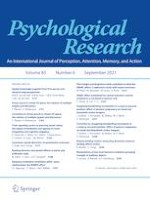02-08-2020 | Original Article
Imagining handwriting movements in a usual or unusual position: effect of posture congruency on visual and kinesthetic motor imagery
Gepubliceerd in: Psychological Research | Uitgave 6/2021
Log in om toegang te krijgenAbstract
Motor imagery has been used in training programs to improve the performance of motor skills. Handwriting movement may benefit from motor imagery training. To optimize the efficacy of this kind of training, it is important to identify the factors that facilitate the motor imagery process for handwriting movements. Several studies have shown that motor imagery is more easily achieved when there is maximum compatibility between the actual posture and the imagined movement. We, therefore, examined the effect of posture congruency on visual and kinesthetic motor imagery for handwriting movements. Adult participants had to write and imagine writing a sentence by focusing on the evocation of either the kinesthetic or visual consequences of the motion. Half the participants performed the motor imagery task in a congruent posture (sitting with a hand ready for writing), and half in an incongruent one (standing with arms crossed behind the back and fingers spread wide). The temporal similarity between actual and imagined movement times and the vividness of the motor imagery were evaluated. Results revealed that temporal similarity was stronger in the congruent posture condition than in the incongruent one. Furthermore, in the incongruent posture condition, participants reported greater difficulty forming a precise kinesthetic motor image of themselves writing than a visual image, whereas no difference was observed in the congruent posture condition. Taken together, our results show that postural information is taken into account during the mental simulation of handwriting movements. The implications of these findings for guiding the design of motor imagery training are discussed.
